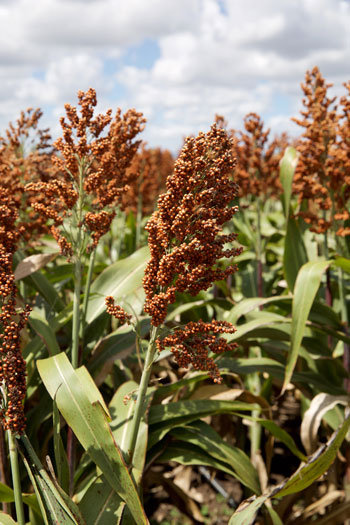Sorghum is heat and drought-resistant, making it a highly suitable summer crop in several regions of Australia. Sorghum grain is consumed as food in many forms around the world; however, in Australia, the market has been limited primarily to low-value animal feed.
In an effort to raise the value of Australian sorghum, the GRDC-supported project ‘Expanding options for sorghum: food and distilling’ explored the properties of Australian-grown varieties and their potential uses in food and beverages.
The project began in 2016 and concluded in 2022, investigating ways of adding value to Australian sorghum as a product for human consumption. The promising results have opened the door for new partners to be among the first to take advantage of the emerging commercialisation opportunities.
Distilling
The project started with an assessment of the market opportunities for sorghum grain exports. Of particular interest was the baijiu market in China. Baijiu is a clear spirit usually distilled from sorghum and is one of the most-popular spirits in the world.
Professor Chris Blanchard of the Functional Grains Centre at Charles Sturt University was the leader of the project. He is excited about the opportunities for raising the value of Australian sorghum.
“We did some market intelligence into that area to get a sense of what the drivers of purchasing were in that market, and there seemed to be some really good opportunities there,” Professor Blanchard says.

Considered to be China’s national drink, baijiu is made of sorghum. About 55 per cent of consumers drink it once a week or more. Photo: Antony Saliba
The next step was to establish the suitability of Australian sorghum varieties for the creation of baijiu.
This started with some small-scale tests to look at fermentation performance, before expanding to a 100-litre pilot where different varieties grown in different areas were compared for ethanol production.
It was found that Australian varieties produced as much, if not more, ethanol than the Chinese variety used as a benchmark.
As baijiu is usually 40 to 60 per cent alcohol, this is a promising start. The next step will be to explore the taste and aromatic properties of the final product produced by these Australian varieties, Professor Blanchard says.
The good news is that red compounds are important in the flavour development of baijiu, and most Australian sorghum varieties are red.
There have even been a couple of baijiu producers open in Australia, which is an industry that has the potential for growth, Professor Blanchard says.
“We’d love to see more sales into China, but we’ve also had a number of people approach us with an interest in establishing baijiu production in Australia. That’s another exciting opportunity for sorghum growers to sell into if it takes off.”
Food products
While increasing the value of sorghum grain exports is an exciting prospect, there is also work being done to expand the options for use of sorghum in human food products produced in Australia.
This part of the project was completed in collaboration with the Sydney Institute of Agriculture at the University of Sydney, with Associate Professor Thomas Roberts leading the research.
“We don’t want to just increase opportunities for grain export of sorghum, but create a dynamic sorghum industry here,” Associate Professor Roberts says. “As a heat-tolerant and drought-tolerant crop, sorghum is a sustainable summer crop for Australia.”
 Researchers are aiming to build a dynamic sorghum industry in Australia. Photo: GRDC
Researchers are aiming to build a dynamic sorghum industry in Australia. Photo: GRDC
The University of Sydney’s research began with trial crops of 13 cultivars – 12 red and one white sorghum. They then analysed the physico-chemical properties of the grains of these Australian varieties to better understand their potential food applications.
An important feature of sorghum is that it is gluten-free, and it is already being used in a few Australian food products as a gluten-free grain alternative. However, these products are few and far between, which is probably a result of a limited understanding of how to process sorghum grain in the Australian food industry, Associate Professor Roberts says.
The project aimed to demystify the properties of sorghum and how it can be processed to create food products. “We now have a solid understanding of how sorghum can be processed for various human food uses, and the challenge now is to convey this information to the appropriate industry bodies.”
A workshop hosted in February 2022 presenting the findings from this research began the process of opening discussions with Australian food production companies, and Associate Professor Roberts hopes to keep the conversation flowing.
It is important, he notes, that sorghum usage is not limited to the gluten-free market only. The research also explored what processes allowed sorghum to maintain the most health benefits.
“A wholegrain sorghum product also has notable health properties such as a high antioxidant content and has a lower protein digestibility than grains like wheat. I think those are important selling points.”
Through honours student research, what food products can be made with sorghum was also investigated. Successful products included popped sorghum, which can be used in products such as muesli bars, a sorghum-based breakfast drink, sorghum oven-baked chips, sorghum vegetable soup and various baked goods using about 50:50 wholegrain sorghum flour and wholegrain wheat flour.
A promising future
Professor Blanchard and Associate Professor Roberts believe this project has provided a promising outlook on the opportunities for boosting the sorghum market’s value in Australia.
“The main goal is to provide growers with more options for selling sorghum,” Professor Blanchard says. “Because most of the sorghum is going to the stockfeed market, there’s not a lot of competition in terms of shopping for higher prices.”
A particularly exciting feature of sorghum is its health benefits. “The work that we do to substantiate the health benefits of sorghum consumption is really going to help market these products, because I think consumers now are looking for products that are not only tasty but also deliver health benefits,” Professor Blanchard says.
Along with investigating the export opportunities, the research project hoped to minimise entry barriers for food producers to take up Australian sorghum. “We’re trying to make it as easy as possible for producers to incorporate sorghum into their product by helping them develop new products and helping troubleshoot any issues that they have in the processing of sorghum.”
Expanding the use of sorghum in human food products has the potential to create many new opportunities for the Australian grain growing and food production industries.
GRDC is looking to work with partners including food processors that are interested in advancing the development of sorghum further and to bridge the gap between value-added sorghum research and market development.
More information: Professor Chris Blanchard, 02 6933 2364, cblanchard@csu.edu.au; Associate Professor Tom Roberts, 02 8627 9147, thomas.roberts@sydney.edu.au; for sorghum research and commercial opportunities with GRDC, contact Dr Michael Groszmann, 02 6166 4538, michael.groszmann@grdc.com.au

























































